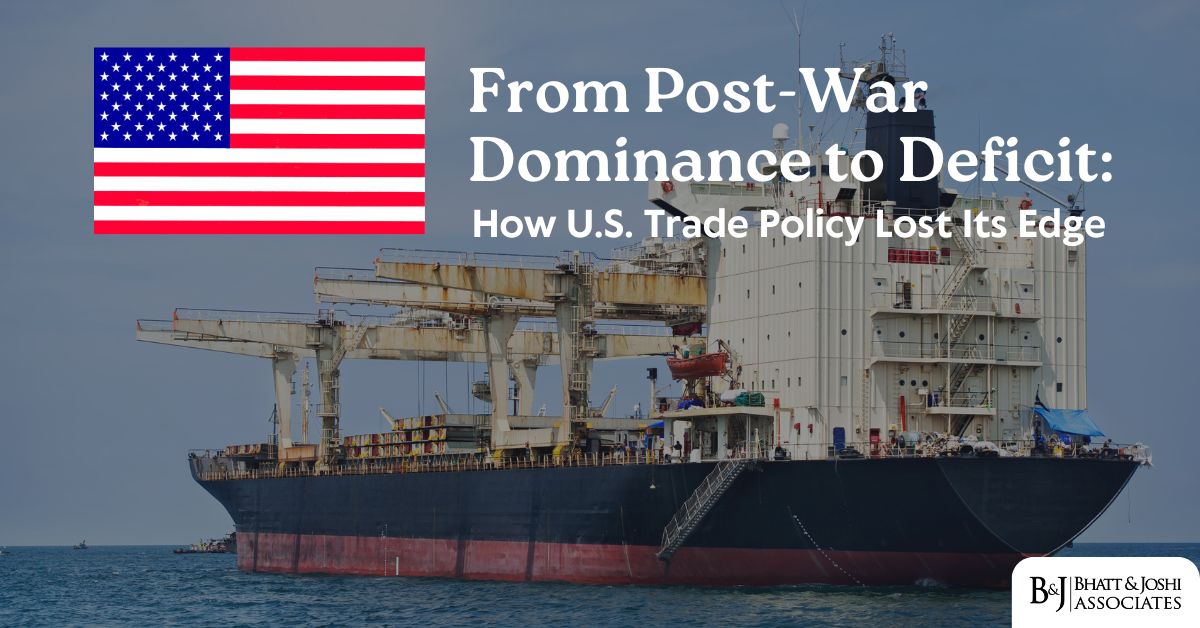Introduction
The story of America’s trade policy transformation from post-World War II dominance to today’s persistent deficits represents one of the most significant economic shifts in modern history. In 1945, the United States stood as an unrivaled economic superpower, possessing nearly half of the world’s manufacturing capacity and controlling the majority of its gold reserves. Today, the nation grapples with a chronic trade deficit exceeding $1 trillion annually, raising fundamental questions about the causes behind the decline of U.S. trade policy and the effectiveness of its economic strategy.
This dramatic reversal didn’t happen overnight. It resulted from a complex interplay of policy decisions, global economic changes, and strategic miscalculations that gradually eroded America’s competitive edge. Understanding this transformation is crucial for policymakers and business leaders seeking to address current economic challenges and chart a course for future prosperity.
The Post-War Economic Landscape
America’s Unrivaled Position
In 1945, the United States emerged from World War II in an unprecedented position of economic strength. While Europe and Asia lay in ruins, American factories had dramatically expanded their capacity through wartime production. The U.S. possessed approximately 75% of the world’s gold reserves and accounted for roughly 50% of global GDP. This economic dominance gave America unprecedented power to shape the post-war international economic order.
The magnitude of this advantage is difficult to overstate. American industries faced virtually no competition in global markets, as potential rivals in Europe and Asia focused on basic reconstruction. U.S. companies dominated sectors from automobiles to electronics, and American technological superiority seemed unassailable.
The Marshall Plan and Economic Strategy
The Marshall Plan, officially the European Recovery Program, represented a masterpiece of economic statecraft. Launched in 1948, it provided over $13 billion (equivalent to about $140 billion today) in aid to Western European nations. While often portrayed as pure altruism, the plan served multiple strategic objectives: preventing the spread of communism, creating markets for American goods, and establishing a stable international economic order aligned with U.S. interests.
The program’s implementation demonstrated remarkable foresight. By helping rebuild European industrial capacity, the U.S. created wealthy trading partners while ensuring their economic and political alignment with American interests. The plan’s success established a model of economic diplomacy that would influence U.S. policy for decades.
Creating the Global Trading System
The United States used its post-war leverage to establish key international economic institutions that would govern global trade. The Bretton Woods Conference of 1944 created the International Monetary Fund (IMF) and the World Bank, while the General Agreement on Tariffs and Trade (GATT) in 1947 set rules for international commerce.
These institutions reflected American economic philosophy, promoting free trade, currency stability, and market-based economics. The dollar became the world’s reserve currency, backed by gold at $35 per ounce, giving the U.S. extraordinary monetary power and economic influence.
The Golden Era of American Trade
Industrial Dominance and Innovation
Throughout the 1950s and 1960s, American industry set global standards for productivity and innovation. U.S. companies dominated sectors from aerospace to consumer electronics. Major corporations like General Electric, IBM, and General Motors became symbols of American industrial might, their products sought after worldwide.
This period saw remarkable technological advances, with American firms leading in areas like computers, telecommunications, and nuclear power. The space race drove innovation in materials science and electronics, with commercial spin-offs benefiting the broader economy.
Trade Surpluses and Economic Growth
During this golden era, the United States consistently ran trade surpluses, averaging about 1% of GDP annually through the 1950s and 1960s. American exports ranged from agricultural products to sophisticated machinery, while high productivity kept U.S. goods competitive despite higher wages.
Economic growth averaged over 4% annually during this period, with manufacturing employment reaching historic highs. The combination of strong exports and technological leadership reinforced America’s economic dominance.
The Dollar’s Global Role
The dollar’s position as the world’s reserve currency provided unique advantages. International trade was primarily conducted in dollars, giving U.S. financial institutions a central role in global commerce. This “exorbitant privilege,” as French finance minister Valéry Giscard d’Estaing called it, allowed the U.S. to run moderate deficits without immediate consequences.
Beginning of the Decline in U.S. Trade Policy
The Nixon Shock and Bretton Woods Collapse
The first major crack in U.S. trade dominance appeared in 1971 when President Nixon ended dollar-gold convertibility. This “Nixon Shock” effectively terminated the Bretton Woods system, leading to floating exchange rates and greater currency volatility.
The decision reflected growing economic pressures, including rising inflation, declining U.S. gold reserves, and early signs of the decline of U.S. trade policy as global dynamics shifted.
The Rise of Japan and Germany
By the 1970s, rebuilt competitors emerged to challenge U.S. industrial leadership. Japan’s export-led growth strategy proved particularly effective, with companies like Toyota and Sony winning market share from American rivals. German firms also recovered, excelling in machinery, chemicals, and luxury goods.
These nations often employed industrial policies more strategic than America’s laissez-faire approach, focusing on export promotion and technological development. Their success challenged assumptions about the superiority of U.S. economic methods.
Early Warning Signs of the Decline of U.S. Trade Policy
The 1970s saw the first sustained U.S. trade deficits of the post-war era. Initially seen as temporary, these deficits highlighted deeper structural changes in the global economy. They marked the beginning of the decline of U.S. trade policy, as America started losing its competitive edge amid rising competition from emerging global players.
The Great Shift in U.S. Trade Dynamics
The Offshoring Revolution
The 1980s and 1990s saw accelerating movement of U.S. manufacturing capacity overseas. Initially focused on labor-intensive industries like textiles and electronics assembly, offshoring gradually expanded to more sophisticated manufacturing. This trend was driven by:
- Lower labor costs in developing countries
- Improved global transportation and communication
- Corporate focus on short-term profitability
- Reduced trade barriers under new international agreements
The impact on American industrial capacity was profound, though initially masked by strong consumer spending and service sector growth.
China’s Economic Emergence
China’s economic reforms, beginning in 1978 under Deng Xiaoping, created a new manufacturing powerhouse. China’s WTO accession in 2001 marked a turning point, as U.S. companies rushed to take advantage of low-cost Chinese labor and production facilities.
The resulting surge in Chinese exports to the U.S. dramatically accelerated the trade deficit. Between 2001 and 2020, the U.S.-China trade deficit grew from $83 billion to over $300 billion annually, representing the largest bilateral trade imbalance in history.
The Growing Trade Deficit
The U.S. trade deficit became structural rather than cyclical, reflecting fundamental changes in the American economy:
- Declining manufacturing capacity
- Increased consumer spending on imported goods
- Growing service sector focus
- Dollar strength maintaining high purchasing power for imports
By 2022, the annual trade deficit exceeded $1 trillion, raising questions about long-term economic sustainability.
Policy Failures and Miscalculations
NAFTA’s Mixed Legacy
The North American Free Trade Agreement (NAFTA), implemented in 1994, exemplifies the complex legacy of U.S. trade policy. While increasing regional trade integration, NAFTA accelerated manufacturing job losses and wage pressure in certain sectors. The agreement’s provisions for labor and environmental protection proved inadequate, while promised job creation often failed to materialize.
WTO and China’s Accession
China’s 2001 WTO accession, strongly supported by U.S. policymakers, rested on assumptions that proved overly optimistic. Expectations of Chinese political liberalization and market opening went largely unfulfilled, while state support for Chinese industries continued. The U.S. failed to effectively address issues like:
- Intellectual property theft
- State subsidies to Chinese companies
- Non-tariff barriers to U.S. exports
- Currency manipulation
Currency Manipulation Challenges
U.S. policy proved ineffective in addressing currency manipulation by trading partners. Despite clear evidence of intervention by countries like China and Japan to maintain export advantages, U.S. responses remained limited and largely ineffective.
Current Challenges in U.S. Trade Policy
Supply Chain Vulnerabilities
The COVID-19 pandemic exposed critical vulnerabilities in U.S. supply chains, particularly in:
- Medical supplies and pharmaceuticals
- Semiconductor manufacturing
- Critical minerals and rare earth elements
- Advanced technology components
These dependencies represent both economic and national security concerns.
Manufacturing Decline
The erosion of U.S. manufacturing capacity continues to pose serious challenges:
- Loss of skilled workforce and technical expertise
- Reduced innovation capacity
- Regional economic decline in former manufacturing centers
- Strategic vulnerabilities in critical industries
Global Competition
The U.S. faces increasing competition in high-technology sectors traditionally dominated by American firms. Chinese initiatives like Made in China 2025 directly challenge remaining areas of U.S. advantage.
The Path Forward for U.S. Trade Policy
Policy Options
Several approaches could help address current challenges:
- Strategic industrial policy targeting critical sectors
- Enhanced protection of intellectual property
- Reformed trade enforcement mechanisms
- Improved workforce development programs
Industrial Strategy
A more coordinated industrial strategy might include:
- Investment in advanced manufacturing capabilities
- Support for research and development
- Infrastructure modernization
- Supply chain resilience initiatives
Trade Reform Possibilities
Potential trade policy reforms could involve:
- Stronger enforcement of existing agreements
- New approaches to currency issues
- Enhanced protection against intellectual property theft
- Strategic reshoring initiatives
Conclusion
The transformation of U.S. trade position from post-war dominance to current deficits reflects both policy choices and broader economic changes. While some decline in America’s relative position was inevitable as other nations recovered from World War II, policy decisions often accelerated this process and failed to adequately protect U.S. economic interests, contributing to the decline of U.S. trade policy.
Addressing current challenges requires recognizing both past policy failures and new economic realities. While complete restoration of post-war trade dominance is neither possible nor desirable, the U.S. can take steps to strengthen its competitive position and ensure more balanced trade relationships.
Success will require a more strategic approach to trade policy, combining domestic industrial renewal with smart international engagement. The goal should be not to recreate past dominance but to establish a more sustainable and equitable trading system that serves both U.S. interests and global economic stability.














